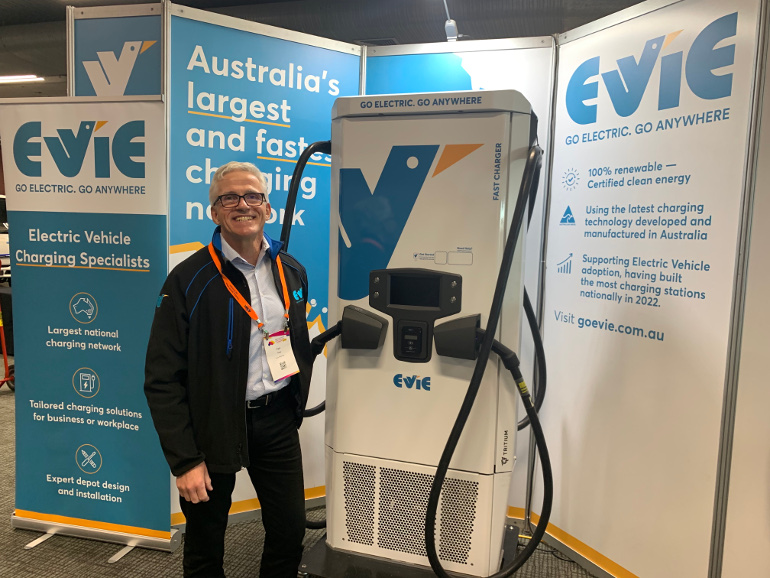Can Australia Lead the World in Public EV Charging?
In this episode of The EV Charging Podcast, Paul Fox—Co-founder and Chief Strategy Officer of Evie Networks—explains why Australia is uniquely positioned to build a world-class public EV charging network.
Fox, a former engineer and Silicon Valley VC, shares insights into the economics, policy roadblocks, battery cost breakthroughs, and fleet electrification strategies shaping the future of Australia’s zero-emissions transport.
“We’re now at the point where EVs are cheaper to run—and in many cases, cheaper to buy—than petrol cars. The infrastructure just has to keep up.”
Highlights from the Conversation
EV Batteries Have Hit the Magic Number
Lithium-ion battery prices have dropped 90% over the past decade—from $1,000/kWh in 2010 to $100/kWh today. That threshold, long considered the tipping point for cost parity, is now reality.
What it means:
- EVs are now cost-competitive with internal combustion vehicles
- Affordable EVs (cheaper than a Corolla) are already in dealerships
- Larger vehicles like vans and utes are next to reach cost parity
Uber Drivers to Electric Utes: Scaling Commercial Electrification
Evie Networks initially deployed EVs for Uber drivers—proving the business case for high-mileage electric transport. Fox now sees small business fleets and white vans as the next major opportunity.
“Electric vans are here. They’re cheaper to run, and tradies know the value of cutting operating costs.”
DC Fast Charging as a Scalable, Profitable Business Model
Unlike many overseas markets burdened by outdated technology, Australia leapfrogged straight to CCS2-compatible DC fast chargers. With strong metro usage, Evie’s network is approaching self-sufficiency—especially in cities.
Why Evie Owns and Operates Its Charging Sites
Paul Fox believes reliability is the single most important factor in scaling public charging—and it requires control.
“If you don’t own the charger, you can’t guarantee reliability. That’s why we operate our own infrastructure.”
This owner-operator model allows Evie to:
- Manage uptime and maintenance directly
- Avoid third-party dependencies
- Maintain consistent charging performance
EV Infrastructure Policy: The DNSP Bottleneck
While battery prices and EV supply are accelerating, grid access remains a major choke point. Paul outlines how Distribution Network Service Providers (DNSPs) are slowing down deployment by:
- Taking up to 24 months to approve or energise sites
- Requiring redundant paperwork and processes
- Lacking internal coordination and prioritisation
Fox calls for DNSP reform:
- Designated EV charging contacts
- Process standardisation across jurisdictions
- Incentives for faster energisation timelines
“It can take a year just to turn the power on, even after the charger is physically installed.”
Network Tariffs: The Hidden Cost Behind Public Charging
Most of the cost to operate a public EV charger isn’t the electricity—it’s the network tariff. In fact, Fox says 60–70% of the electricity cost paid by charging networks comes from outdated pricing structures designed for factories, not transport.
Evie is pushing for:
- Volumetric tariffs tied to actual energy use
- Critical peak pricing, with usage alerts for drivers
- Support for solar-rich grid load management
“We can throttle power. We can move drivers to off-peak. But we need fair pricing that reflects EV load flexibility.”
Government’s Role: Seed Funding, Then Step Back
Public money was essential for kickstarting Australia’s DC fast-charging network—especially in regional areas. But Fox believes the private sector is now ready to fund growth, particularly in metro corridors.
Key takeaways:
- Metro charging is nearing financial self-sufficiency
- Government should now focus on regional infrastructure
- Policy should support tariff reform, not just hardware grants
Australia’s Advantage: Learning From Global Mistakes
Australia’s late start has turned into a strategic edge. While the US and Europe struggled with fragmented standards and stranded assets, Evie avoided the pitfalls by:
- Committing early to CCS2 connectors
- Skipping low-powered AC public chargers
- Avoiding public kerbside charging where usage is low
“We’ve been able to leapfrog mistakes made overseas. Our network is newer, faster, and more focused.”
What’s Next: The EV Adoption Tipping Point
With over 10 new EV models launching in 2025, and Chinese manufacturers flooding the market with affordable vehicles, Paul Fox sees the coming year as a pivotal moment.
Already, Evie data shows clusters of full-time public charging users—including:
- High-mileage Uber drivers
- Apartment dwellers with no home charging
- Contractors and van operators
Final Thoughts: Public Charging as an Equity Issue
Paul believes the future of EV adoption depends on ensuring access and affordability for drivers who can’t install home chargers.
“If we want widespread adoption, we can’t just think about people with garages and solar panels.”
Listen to the Full Episode
If you care about the future of transport, energy affordability, infrastructure, or climate policy in Australia, this conversation with Paul Fox is essential listening.
Stream the episode on your favourite podcast platform or watch on YouTube.
Frequently Asked Questions
What is Evie Networks’ business model?
Evie is an owner-operator of DC fast chargers, allowing it to ensure network reliability and manage long-term infrastructure.
How much does battery price affect EV affordability?
Battery pack prices hitting $100/kWh now make EVs cost-competitive with petrol vehicles, especially in smaller segments.
What are DNSPs and why do they matter?
DNSPs (Distributed Network Service Providers) control grid access. Their approval timelines and processes can significantly delay charger installations.
What is tariff reform and why is it important?
Current pricing structures penalise fast chargers with high demand fees. Reform would enable flexible pricing that better matches EV charging patterns.
- Home & Business Battery Scheme NT: Save Up to $12,000 (2025 Guide) - 23 April, 2025
- Paul Fox | Evie Networks Strategy, Policy & Battery Breakthroughs | Australia’s Fastest Growing EV Charging Network - 22 April, 2025
- From Passion to Purpose: Dave Watson on the Future of EV Charging in Australia - 16 April, 2025
